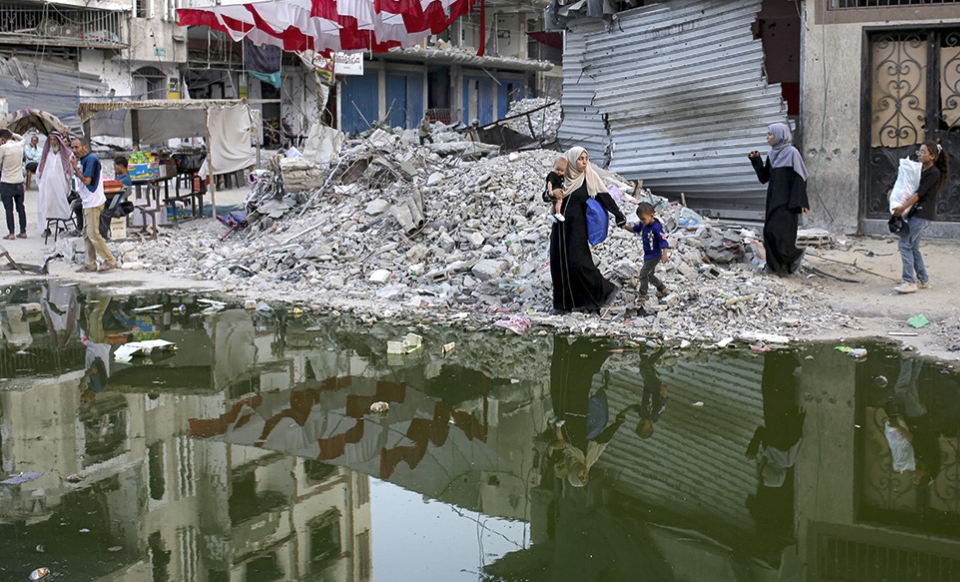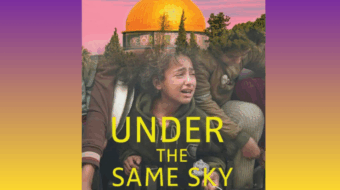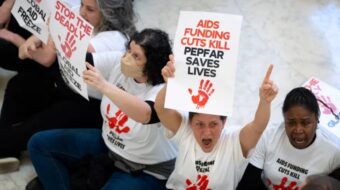
After 25 years without polio, the siege of Gaza has directly resulted in a confirmed case of childhood paralysis, in what could be the start of a polio outbreak.
The British biologist Peter Medawar described a virus as “a piece of bad news wrapped up in protein.” The virus that causes polio provides a perfect example.
When a cell infected with poliovirus dies, it bursts open and can release up to 10,000 individual virus particles. Each contains the poliovirus genome in a protective package which protects the delicate viral genome from being destroyed, allowing it to survive for months in most environments.
This allows the virus to wreak havoc again once it encounters another cell. For example, when feces from somebody infected with polio contaminates drinking water, the viral particles float in the water too. Once ingested by another person, a particle can activate itself and inject the viral genome into their cells, starting the cycle again.
Poliovirus needs humans to live. As far as we know, it cannot infect any other living organism. Most of the people it infects experience no symptoms, but in some cases, it causes debilitating paralysis and death, a side-effect of its proliferation inside the body.
Back in the 1950s, poliovirus paralyzed or killed more than half-a-million people a year all over the world, most of them children. But the advent of vaccination changed the picture.
The polio vaccine has been a dramatic success story, almost eliminating the disease. If everyone was vaccinated against polio, the surviving viral particles out there in the world would slowly decay until polio is gone forever.
However, in a few places around the world, the viral particles are still able to reproduce, flaring up and spreading through unvaccinated individuals like a chain reaction.
Polio vaccination uses a weakened form of the virus. Unfortunately, in some cases, the weakened form of the virus used for vaccination can mutate to become active again.
These occurrences are extremely rare—but with millions of people and trillions upon trillions of viral particles, small probabilities lead to measurable numbers of cases.
This vaccine-derived virus can then spread through human populations like a natural virus. Vaccine-derived strains are now the major cause of most polio cases worldwide.
In 2023, just over 500 cases of paralysis were reported by them globally. As long as vaccination rates are high, vaccine-derived strains don’t pose a threat, but once they drop, the strains become dangerous to unvaccinated children.
Palestine has been polio-free for over 25 years thanks to vaccination and sanitation. In 2022, vaccination coverage was estimated at 99%. But on June 23 this year, sewage samples in Gaza were found to contain vaccine-derived poliovirus—an indication that the virus might be spreading in the population.
The first case was confirmed by the Palestinian Ministry of Health on Aug. 16 in an unvaccinated 10-month-old child; a week later, the World Health Organization (WHO) said the child was now paralyzed. Polio has returned to Gaza.
This is an entirely predictable result of an illegal onslaught on civilian infrastructure by Israel. When the detection of poliovirus was first reported, the director-general of the WHO, Tedros Adhanom Ghebreyesus, said that the situation in Gaza was “perfect” for the spread of diseases like polio.
We wrote back in October 2023 that the denial of water to Gaza by Israel after the Oct. 7 attacks by Hamas was only the latest step in a decades-long water crisis, one created by the actions of the Israeli government.
Since then, the situation has continued to deteriorate. In May, BBC analysis of satellite images concluded that over 50% of water facilities had been damaged or destroyed. By July, a report from Oxfam found that access to water had fallen by 94%.
That report stated that all wastewater treatment plants had been destroyed, along with 70% of sewage pumps and both of Gaza’s main water quality testing laboratories. In Gaza City, all desalination plants and 88% of wells were either damaged or destroyed.
A former special adviser to the International Criminal Court, Leila Sadat, told the BBC that they believed such levels of destruction could not be accidental: “The pattern is evidence of either a reckless approach to civilian objects or the intentional destruction of them; these were not all mistakes.”
In such conditions, there is little distinction between drinking water and raw sewage. On Monday of this week, BBC Arabic used satellite analysis to identify a sewage discharge on Gaza’s coastline covering over 2 sq. km.
If other children within Gaza have polio, as seems highly likely, the virus will be spreading in contaminated water that unvaccinated and thirsty children have no choice but to drink.
The fiction of “humanitarian zones” is that they are somehow safe areas. One worker from the U.N. agency for Palestinian refugees, UNRWA, said that the “humanitarian zone” in Gaza is now just 11% of the Gaza Strip: “These are sand dunes, crowded areas, where people are living […] amid garbage, amid lakes of sewage.”
The IDF takes the threat of polio seriously—for their own soldiers. In a press statement on July 21, it said that it was vaccinating its active soldiers against polio.
But the situation for civilians in Gaza is quite different. Though some have been vaccinated since the siege began, according to Human Rights Watch, the Israeli government continues to block ongoing vaccination efforts.
So far this month, the government has denied a third of planned humanitarian aid missions. That is before one even considers the near-impossibility of delivering and distributing vaccines safely once they arrive in Gaza.
More than 1.2 million doses arrived in Gaza on Monday to vaccinate more than 640,000 children. But to take just one example of the difficulty of vaccinating children amid the destruction, UNICEF has estimated that there at least 17,000 of them are now unaccompanied or separated.
Polio is natural, but its re-emergence in Gaza is the direct result of human action. A 2018 systematic review found that the following were risk factors for the spread of infectious disease: “crowded conditions, forced displacement, poor-quality shelter, poor water, sanitation and hygiene, lack of healthcare facilities and lack of adequate surveillance.”
All of these are met in Gaza today—and without a ceasefire and an end to the occupation, they can only get worse. Taking action against a possible polio outbreak is only one element of the crisis.
An immediate ceasefire has been desperately needed since October of last year. But as things stand, an urgent vaccination effort will be taking place on the ground while the IDF keeps dropping bombs from the air.
Morning Star
We hope you appreciated this article. At People’s World, we believe news and information should be free and accessible to all, but we need your help. Our journalism is free of corporate influence and paywalls because we are totally reader-supported. Only you, our readers and supporters, make this possible. If you enjoy reading People’s World and the stories we bring you, please support our work by donating or becoming a monthly sustainer today. Thank you!










